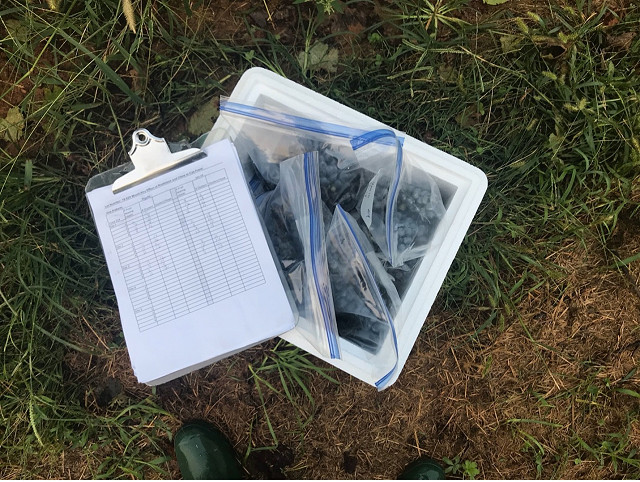Vineyard sampling methods: clusters vs. berries vs. whole vine

It comes up every year. Which is better – cluster sampling or berry sampling? After reading through some of the available literature, here is what I have found so far:
- Both cluster sampling and berry sampling yield roughly the same overall Brix numbers (1,2). Not all papers look beyond Brix, but those that did found similar pH, TA, and phenolics numbers as well (3). However, these were all done with adequate number of clusters and berries per sample (see below). It is also important to note most of these studies were done in very small plots. Results may be different with production sized vineyards.
- Berry sampling gives a lower overall variation than cluster sampling. Amerine and Roessler (1958)(1) compared three sampling methods: berry, cluster, and sentinel vine sampling. When they compared the results of berry samples (100-200 berries), cluster samples (10 clusters each) and whole vine harvesting, they found they all of the methods averaged around the same mean Brix level. However, the variation between samples was least for berry samples and most for whole vine samples. This means that the range of possible answers when they sampled these 10 times was wider for whole vines and clusters than berries. They concluded that sentinel vine sampling is best for uniform vineyards and clusters are best for varieties that are known to have large variations within clusters (Zinfandel in California, potentially Petit Verdot for Virginians), but berries are most appropriate for most varieties.
- Several investigations found that between vine variation was larger than within vine or within cluster variation, even in very small experimental plots (18 – 33 vines)(2,4,5). It is likely the between-vine variation in a full vineyard block is even higher. Sampling a larger number of vines/rows may be more important than sampling all of the berries in the cluster.
- One argument cited against berry sampling is that the outside berries (sampled with berry sampling) do not represent the berries within the cluster well. Tang et al (2019)(3) studied the relationship between visible berries and bunch maturing in Chardonnay and Shiraz. They found strong correlations in Brix, pH and TA with slightly less correlation in anthocyanins and phenolics. The correlation was not always 1:1, but was consistent year to year, allowing for correction. They also found the correlation was stronger with a larger number of samples and as fruit was riper (meaning, there was more within cluster variation early in ripening than later). In their models, Brix measurements from outer berries were within +/- 0.58 units of the whole bunch in Chardonnay and +/- 0.62 in Shiraz.
How many berries or clusters do you need to get a representative sample?
Unfortunately, most of the studies I have found so far focus on precision (how likely are you to get the same number each time) rather than accuracy (how closely does your result match the juice at harvest). However, when deciding your target sample size, consider the following:
- When determining the sample size needed to discriminate differences in experimental plots, Kasimatis and Vilas (1985)(2) found that two 50-berry samples and two 10-cluster samples were equally sensitive.
- Rankine et al (1962)(4) compared results from a 32-cluster sample with the actual value of 0.5 ton harvest from 34 different vineyards. Of these, 19 samples estimated the true value within 0.5 Brix while 15 differed by more than 1.0 Brix. Berry samples were not used in this portion of the work. The same authors found that berry samples (100 berries and 200 berries) did as well or better estimating the Brix level when compared to total crop as 64 cluster samples. Both methods were more likely to overestimate Brix levels than underestimate them.
- Zoecklein (Enology Notes 54) recommends the following guidelines for sampling size:
- Within 1 degree Brix: 2x100 berries or 10 clusters
- Within 0.5 degree Brix: 5x100 berries (no cluster number is given)
Ultimately the best way to determine the sampling method that is most accurate for your vineyard is to do both types of samples just before harvest, and see which is most accurate once the harvest comes in. Sounds like a great experiment!
References
- Amerine, M. A.; Roessler, E. B. Field Testing of Grape Maturity. Hilgardia 1958, 28 (4), 93–114.
- Kasimatis, A. N.; Vilas, E. P. Sampling for Degrees Brix in Vineyard Plots. American Journal of Enology and Viticulture 1985, 36 (3), 207–213.
- Tang, J.; Petrie, P. R.; Whitty, M. Modelling Relationships between Visible Winegrape Berries and Bunch Maturity: Visible versus Bunch Maturity. Australian Journal of Grape and Wine Research 2019, 25 (1), 116–126.
- Rankine, B. C.; Cellier, K. M.; Boehm, E. W. Studies on Grape Variability and Field Sampling. American Journal of Enology and Viticulture 1962, 13, 58–72.
- Wisdom, J. M.; Stuckey, A. W.; Considine, J. A. Hierarchical Modelling Partitions Variation in Vineyard Fruit Maturity for Optimal Sampling. Australian Journal of Grape and Wine Research 2020, 26 (2), 148–157.
